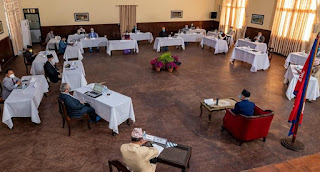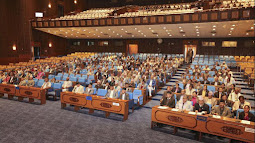Executive (CIVIC AWARENESS)
Unit 5: CIVIC AWARENESS
Lesson 2: Executive
Introduction
Executive body
is also called the council of ministers; is the law implementing body of the
state. Among the three important organs of the nation (Legislative, Executive,
Judiciary) Executive body plays a vital role in national development as it
has to work on the field. There are three levels of executives in Nepal federal
Executive at the center, Provincial Executive at province and
Local
Executive at the local level.
Federal Executive: Federal executive is
the higher executive of the country that has authority over the federal
government or the whole country. The prime minister is the head of the council
of ministers in federal executives and other ministers are members of it.
Executive power of federal Executive: The power is vested in the Council of Ministers with the
responsibilities such as; issuing general directives, controlling and
regulating the government of Nepal.
Constitution of Council of Ministers:
1. Leader of Parliamentary
party is appointed by the president, s/he commands a majority in the House of
representative as a Prime Minister and
Council of Ministers under his/her chairpersonship,
2. In case no party has clear
majority under clause (1), the President appoints a member as the Prime Minister
who can command with support of two or more parties,
3. If Prime Minister can’t be
appointed under clause (2), then the
party leader which has the highest number of members is appointed as the
prime minister,
4. The Prime Minister
appointed under clause (2/3) shall obtain a vote of confidence in no later than
30 days of appointment,
5. In case the Prime Minister under
clause (3) fails to obtain the vote of confidence, any member under clause (2)
presents a ground where s/he can obtain a vote of confidence and the President
shall appoint such member as prime minister,
6. That Prime Minister under
clause (5) shall obtain a vote of confidence under clause (4),
7. In case s/he fails to
secure vote of confidence, the President shall dissolve the house of
representative and appoint a date of election to another house of
representative,
8. Procedures on the
appointment of the Prime Minister must be completed within thirty-five days
after the final result of the election of house of representative,
9. The President shall
constitute the Council of Minister comprising a maximum of twenty-five
ministers (deputy prime minister, minister, minister of state and assistant
minister) including the prime minister
10. The Prime Minister and Ministers
shall be responsible to the Federal Parliament and the Ministers shall be
individually responsible for the work of their respective Ministries to the Prime
Minister and the Federal Parliament,
Function of Executive
1.
Administrative function
The main function of the executive is to implement the laws formulated by the legislature.
It also prepares the policies and programs of state and maintains good
governance in the country.
2.
Diplomatic function
The
executive determines the foreign policy, extends the relation with other
countries makes treaties and agreement and also appoints the ambassadors to
foreign countries.
3.
Financial function
The executive is responsible for financial mobilization of the country. It imposes
taxes, introduce budget and mobilize the revenue and take loans if needed.
4.
Military function
Executive controls mobilize and manages the Nepalese Army to provide security
to the state from being attacked by the internal and the external fractions. It
protects the country from all possible foreign attacks and maintains peace and
law in order. The president can appoint or remove the chief of army force office
on the recommendation of the Council of Ministers; the president is the supreme
commander-in-chief of the Nepal army.
Provincial Executives: In Nepal, there are 7 Provincial executives which
are the higher authority of the state and they have authority within their own
state. Chief Minister is the head of the Council of Minister. Every state has
its own provincial executives.
Executive power of
provincial.
The executive power of a province is vested
in the provincial council of ministers with the responsibilities for issuing
general directives, controlling and regulating the governance of the province.
Composition of the provincial council of ministers
The chief of the province appoints the leader
of the parliament party commanding majority in the provincial assembly as chief
minister and the state council of ministers is constituted under his/her
chairpersonship.
Nepal has been divided
into 7 provinces, 77 districts and 753 local level (local governments) among
them there are 460 Gaunpalikas (Rural municipality), 276 Municipalities, 11 sub
metropolises and 6 metropolises. (Till 2077 BS) it is the matter of upgrade.
Executive power of
local level
The executive power is vested in Rural
Municipal Executive or the Municipal Executive with the responsibility for
issuing general directives, controlling and governing the Rural Municipality.
There is a chairperson in each Rural Municipality and a mayor in each the municipality and the Rural Municipal Executive and municipal executive are
formed under their chairpersonship respectively.
President of Nepal
The president is elected by an electoral college comprising
the Parliament of Nepal and the members of the provincial legislatures. A
law shall determine the weight of each of their votes.
Whoever receives a majority of the delegates' votes is elected.
If no one receives a majority in the first round, runoffs are held between the
top two candidates until one receives a majority.
The term of office of President shall be five years. The
qualifications to become qualified as the president are:
1.
Being
qualified to become a member of federal parliament,
2.
Having
completed the age of at least forty-five years, and
3.
Not
being disqualified by any law,
A person elected twice as the president shall not become a
candidate in the election. In the absence of the president, the vice-president
shall fulfil the duty of the president.




Comments
Post a Comment
Thank you for your comment: